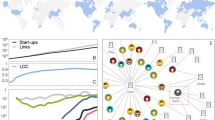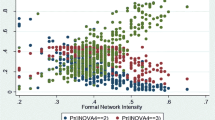Abstract
This paper compares a firm’s innovation and performance with its online Web presence measured through the Web network structure. 489 firms in five different industries listed on the United States and Chinese stock markets are investigated. Using Web link data collected from Bing, blogs, Twitter and Wikipedia, we find positive correlation between betweenness centrality of a firm in the Web network and its innovation capability; and between betweenness centrality and financial performance. In order to get more accurate forecasting results, regression analysis is done for each industry and the combined industries in the United States and China. We also find that Twitter and Wikipedia only predict a firm’s performance in the United States, which is not surprising as they are officially blocked in China. Blogs predict better in China than they do in the United States, as it might still be a major social media tool for Chinese firms; while for the US firms, blogs have been supplemented by Twitter and Wikipedia.




Similar content being viewed by others
Explore related subjects
Discover the latest articles, news and stories from top researchers in related subjects.Notes
References
Adler P, Kwon SW (2002) Social capital: prospects for a new concept. Acad Manag Rev 27:17–40
Ahuja Gautam (2000) Collaboration networks, structural holes, and innovation: a longitudinal study. Adm Sci Q 45:425–455
Aldrich H (1989) Networking among women entrepreneurs. In: hagan o, Rivehun C, Sexton D (eds) Women-owned businesses. Praeger, New York, pp 103–132
Anderson A, Park J (2007) Entrepreneurial social capital: conceptualizing social capital in new hightech firms. Int Small Bus J 25(3):245–272
Baldwin TT, Bedell MD, Johnson JL (1997) The social fabric of a team-based M.B.A. program: network effects on student satisfaction and performance. Acad Manag J 40:1369–1397
BarNir A, Smith KA (2002) Interfirm Alliances in the Small Business: the Role of Social Networks. J Small Bus Manag 40(3):219
Beckman CM, Haunschild PR, Phillips DJ (2004) Friends or Strangers? Firm-specific uncertainty, market uncertainty, and network partner selection. Org Sci 15:259–275
Bollen J, Mao H, Zeng X (2011) Twitter mood predicts the stock market. J Comput Sci 2(1):1–8
Borgatti SP, Feld SL (1994) How to test the strength of weak ties theory. Connections 17(1):45–46
Brass DJ (1984) Being in the right place: a structural analysis of individual influence in an organization. Adm Sci Q 29:518–539
Brin S, Page L (1998) The anatomy of a large-scale hypertextual web search engine. Stanford University, Stanford
Bulkley N, Van Alstyne M (2006) An empirical analysis of strategies and efficiencies in social networks. http://ssrn.com/abstract=887406). Accessed 15 Jan 2012
Burt RS (1992) Structural holes: the social structure of competition. Harvard University Press, Cambridge
Capaldo A (2007) Networks structure and innovation: the leveraging of a dual network as a distinctive relational capability. Strateg Manag J 28:585–608
Charls F, Webber CF (2003) Expanding educative possibilities. J Educ Adm 41(2):201–218
Christensen C (1997) The innovator’s dilemma. Harvard Business School Press, Boston
Coleman JS (1988) Social capital in the creation of human capital. Am J Sociol 94:95–120
Cross R, Cummings J (2004) Tie and network correlates of individual performance in knowledge-intensive work. Acad Manag J 47(6):928–937
DeBresson C, Amesse F (1991) Networks of innovators: a review and introduction to the issue. Res Policy 20:363–379
Doving E, Gooderham PN (2008) Dynamic capabilities as antecedents of the scope of related diversification: the case of small firm accountancy practices. Strateg Manag J 29(8):841–857
Drucker PF (1984) The discipline of innovation. Harvard Bus Rev 63(3):67–72
Freeman LC (1978/79) Centrality in social networks: conceptual clarification, Soc Netw 1: 215–239
Freeman LC, Roeder D, Mulholland RR (1979/80) Centrality in social networks: ii, experimental results, Soc Netw 2: 119–141
Frick K, Guertler D, Gloor P (2013) Coolhunting for the World’s thought Leaders. In: Proceedings 4th international conference on collaborative innovation networks COINs13, Santiago de Chile. http://arxiv.org/pdf/1308.1160.pdf
Gabbay SM, Leenders RTA (1999) The structure of advantage and disadvantage. In: Leenders RTA, Gabbay SM (eds) Corporate social capital and liability. Kluwer, New York, pp 1–16
Giuliani E, Bella M (2005) The micro-determinants of micro-level learning and innovation: evidence from a chilean wine cluster. Res Policy 34:47–68
Gloor PA (2005) Swarm creativity: competitive advantage through collaborative innovation networks. Oxford University Press, Oxford
Gloor P, Zhao Y (2004) A temporal communication flow visualizer for social networks analysis, ACM CSCW workshop on social networks, ACM CSCW conference, Chicago. 6 Nov
Gloor P, Laubacher R, Dynes S, Zhao Y (2003) Visualization of communication patterns in collaborative innovation networks: analysis of some W3C working groups. In: Proceedings of ACM CKIM international conference on information and knowledge management, New Orleans. 3–8 Nov
Gloor P, Paasivaara M, Schoder D, Willems P (2007) Finding collaborative innovation networks through correlating performance with social network structure. Int J Prod Res 46(5):1357–1371
Gloor P, Krauss J, Nann S, Fischbach K, Schoder D (2009) Web Science 2.0: Identifying trends through semantic social network analysis. In: IEEE conference on social computing (SocialCom-09), Vancouver. 29–31 Aug
Gloor P, Dorsaz P, Fuehres H (2011) Analyzing success of startup entrepreneurs by measuring their social network distance to a business networking hub. In: Proceedings 3rd international conference on collaborative innovation networks coins, Basel. Sept 8–10
Granovetter MS (1973) The strength of weak ties. Am J Sociol 78:1360–1380
Gulati R, Nohria N, Zaheer A (2000) Strategic networks. Strateg Manag J 21(3):203–215
Hanneman RA, Riddle M (2005) Introduction to social network methods. University of California, Riverside (published in digital form at http://faculty.ucr.edu/hanneman/)
Henard D, Szymanski D (2001) Why some new products are more successful than others. J Mark Res 38:362–375
Hooke JC (2010) Security analysis and business valuation on wall street: a comprehensive guide to today’s valuation methods (Wiley Finance). Wiley, Hoboken NJ
Iyer B, Lee CH, Venkatraman N (2006) Managing in a small world ecosystem: some lessons from the software sector. Calif Manag Rev 48(3):28–47
Jenssen JI, Koenig HF (2002) The effect of social networks on resource access and business startups. Eur Plan Stud 10(8):1039–1046
Kidane Y, Gloor P (2005) Correlating temporal communication patterns of the eclipse open source community with performance and creativity. North American Association for Computational Social and Organizational Science Conference, Notre Dame. 26–28 June
Lavie D (2007) Alliance portfolios and firm performance: a study of value creation and appropriation in the U.S. Software Industry. Strateg Manag J 28(12):1187–1212
Li W (2006) Development and effect of state-owned and state holding enterprises group. Stat Res 11:9–14
Li C (2009) New study: deep brand engagement correlates with financial performance, (downloaded on 12 February 2012 from http://www.altimetergroup.com/2009/07/engagementdb.html)
Lin N (2008) A network theory of social capital. In: Castiglione D, Van Deth J, Wolleb G (eds) The handbook on social capital. Oxford University Press, New York, pp 50–69
Luo X, Zhang J, Duan W (2003) Social media and firm equity value. Inf Syst Res 24(1):146–163
Malerba F, Vonortas NS (2009) Innovation networks in industries. Edward Elgar Pub, Cheltenham
Marinova D, Phillimore J (2003) Models of Innovation. In: Shavinina LV (ed) The international handbook of innovation. Elsevier Science Ltd, Oxford, pp 44–53
McEvily B, Marcus A (2005) Embedded ties and the acquisition of competitive capabilities. Strateg Manag J 26(11):1033–1055
Mehra A, Kilduff M, Brass DJ (2001) The social networks of high and low self-monitors: implications for workplace performance. Adm Sci Q 46:121–146
Milgram S (1967) The small world problem. Psychol Today 2:60–67
Mintz B, Schwartz M (1985) The power structure of American business. University Chicago Press, Chicago
Mizruchi MS (1982) The American Corporate Network 1904–1974. Sage Publications, Beverly Hills
Moat HS, Curme C, Avakian A, Kenett DY, Stanley HE, Preis T (2013) Quantifying wikipedia usage patterns before stock market moves. Sci Rep 3:3141
Nahapiet J, Ghoshal S (1998) Social capital, intellectual capital, and the organization advantage. Acad Manag Rev 23:242–266
Nohria N, Eccles RG (1992) Networks and organizations: structure, form and action. Harvard Business School Press, Boston
Pittaway L, Robertson M, Munir K, Nenyer D, Neely A (2004) Networking and innovation: a systematic review of the evidence. Int J Manag Rev 5(6):137–168
Podolny JM (1993) A status-based model of market competition. Am J Social 98(4):829–887
Podolny JM, Stuart TE, Hannan MT (1996) Networks, knowledge and niches: competition in the worldwide semiconductor industry 1984–1991. Am J Sociol 102:659–689
Preis T, Moat HS, Stanley HE (2013) Quantifying trading behavior in financial markets using Google Trends. Sci Rep 3:1684
Provan KG, Kenis P (2007) Models of network governance: structure, management, and effectiveness. J Public Adm Res Theory 18:229–252
Reinhart CM, Rogoff KS (2009) This time is different: eight centuries of financial folly. Princeton University Press, Princeton
Rindfleisch Aric, Moorman Christine (2001) The acquisition and utilization of information in new product alliances: a strength-of-ties perspectives. J Market 65:1–18
Schilling MA, Phelps CC (2005) Interfirm collaboration networks: the impact of small world connectivity on firm innovation. Manag Sci 53(7):1113–1126
Shaw, M., Communication Networks. In: Berkowitz, L. Advances in Experimental Social Psychology, Academy Press, New York, NY (1964)
Sparrowe RT, Liden R (1997) Process and structure in leader–member exchange. Acad Manag Rev 22:522–552
Sparrowe RT, Liden RC (2005) Two routes to influence: integrating leader–member exchange and network perspectives. Adm Sci Q 50:505–535
Tashiro H (2011) Email network analysis for leadership, 1456–1460. Industrial Engineering and Engineering Management (IEEM), Singapore
Tsai W (2001) Knowledge transfer in intra-organizational networks: effects of network position and absorptive capacity on business unit innovation and performance. Acad Manag J 44(5):996–1005
Tsai W, Ghoshal S (1998) Social capital and value creation: the role of intrafirm networks. Acad Manag J 41:464–476
Wang G, Liu R (2009) Empirical research of network embeddedness’ impact on firm’s export performance. Syst Eng 6:54–60
Wasserman S, Faust K (1994) Social network analysis: methods and applications, 1st edn. Cambridge University Press, New York
Wellman B, Berkowitz SD (1997) Social structures: A network approach. JAI Press Inc, London
Zhang X, Fuehres H, Gloor PA (2011) Predicting stock market indicators through twitter “I hope it is not as bad as I fear”. Proc Soc Behav Sci 26:55–62
Zhou L, Wu W, Luo X (2007) Internationalization and the performance of born global SMEs: the mediating role of social networks. J Int Bus Stud 38(4):673–690
Acknowledgments
This research has been supported by National Natural Science Foundation of China Project No.71272144, Social Science and Humanity on Young Foundation of the Ministry of Education of China Project No.10YJC870044, and Soft science research project of Guangdong province No. 2013B070206046.
Author information
Authors and Affiliations
Corresponding author
Rights and permissions
About this article
Cite this article
Yun, Q., Gloor, P.A. The web mirrors value in the real world: comparing a firm’s valuation with its web network position. Comput Math Organ Theory 21, 356–379 (2015). https://doi.org/10.1007/s10588-015-9189-6
Published:
Issue Date:
DOI: https://doi.org/10.1007/s10588-015-9189-6




